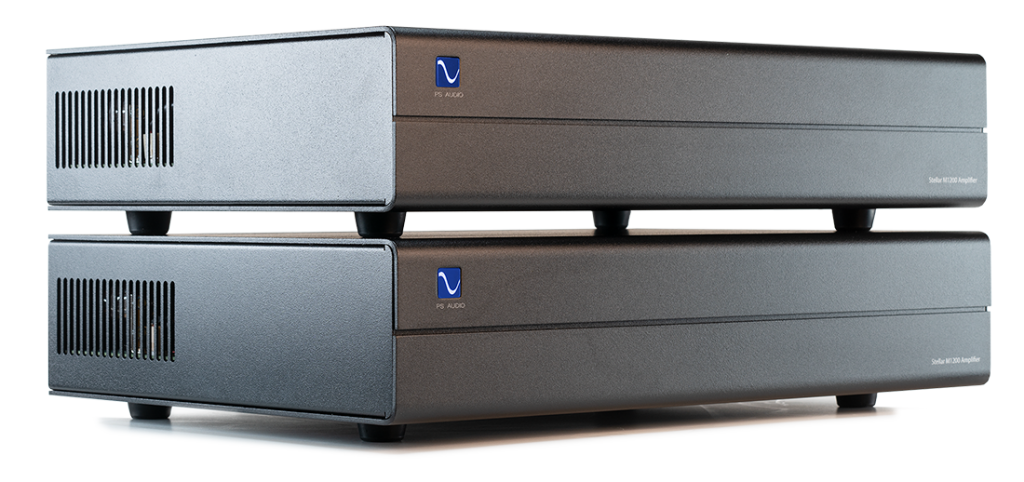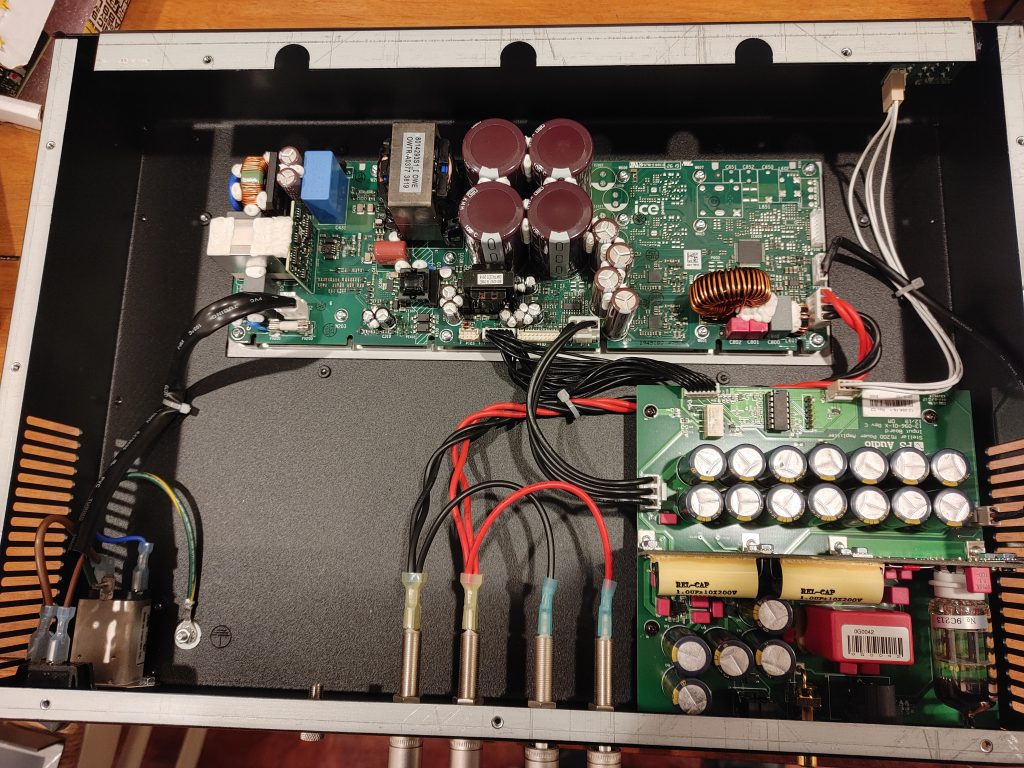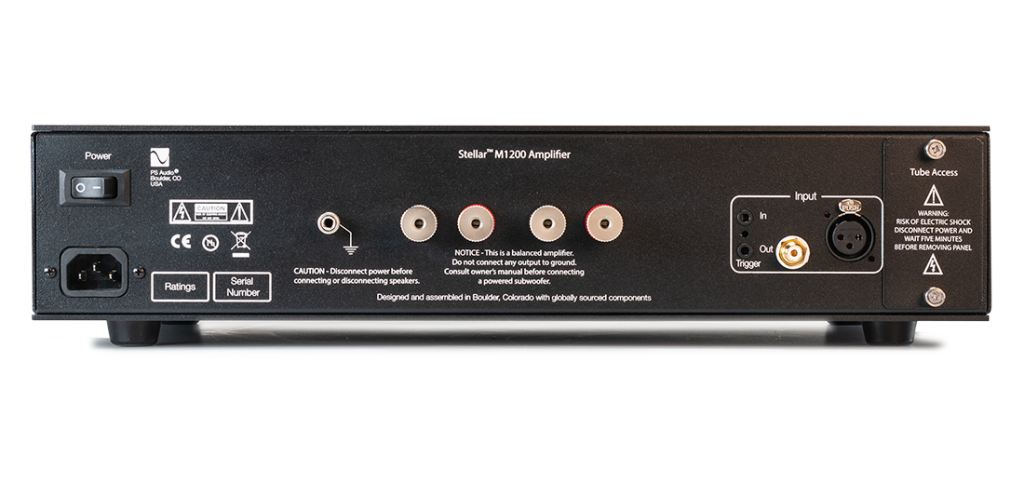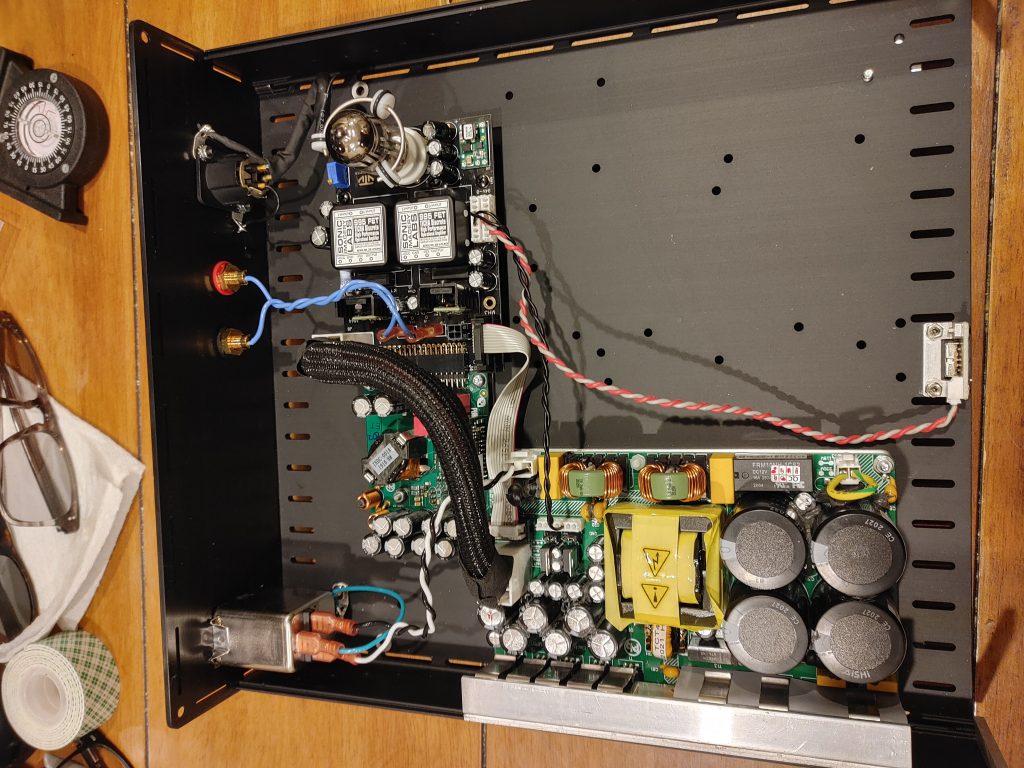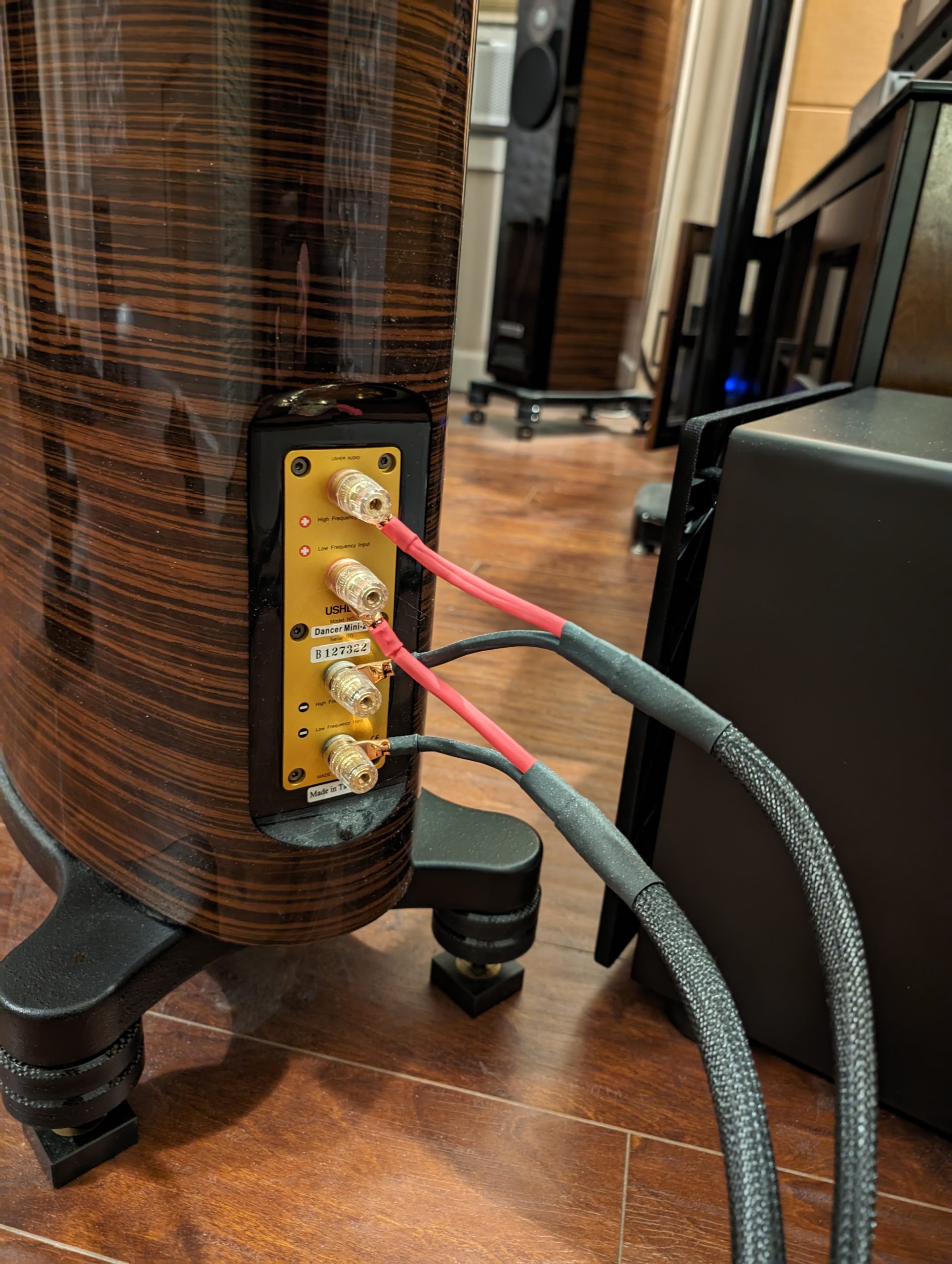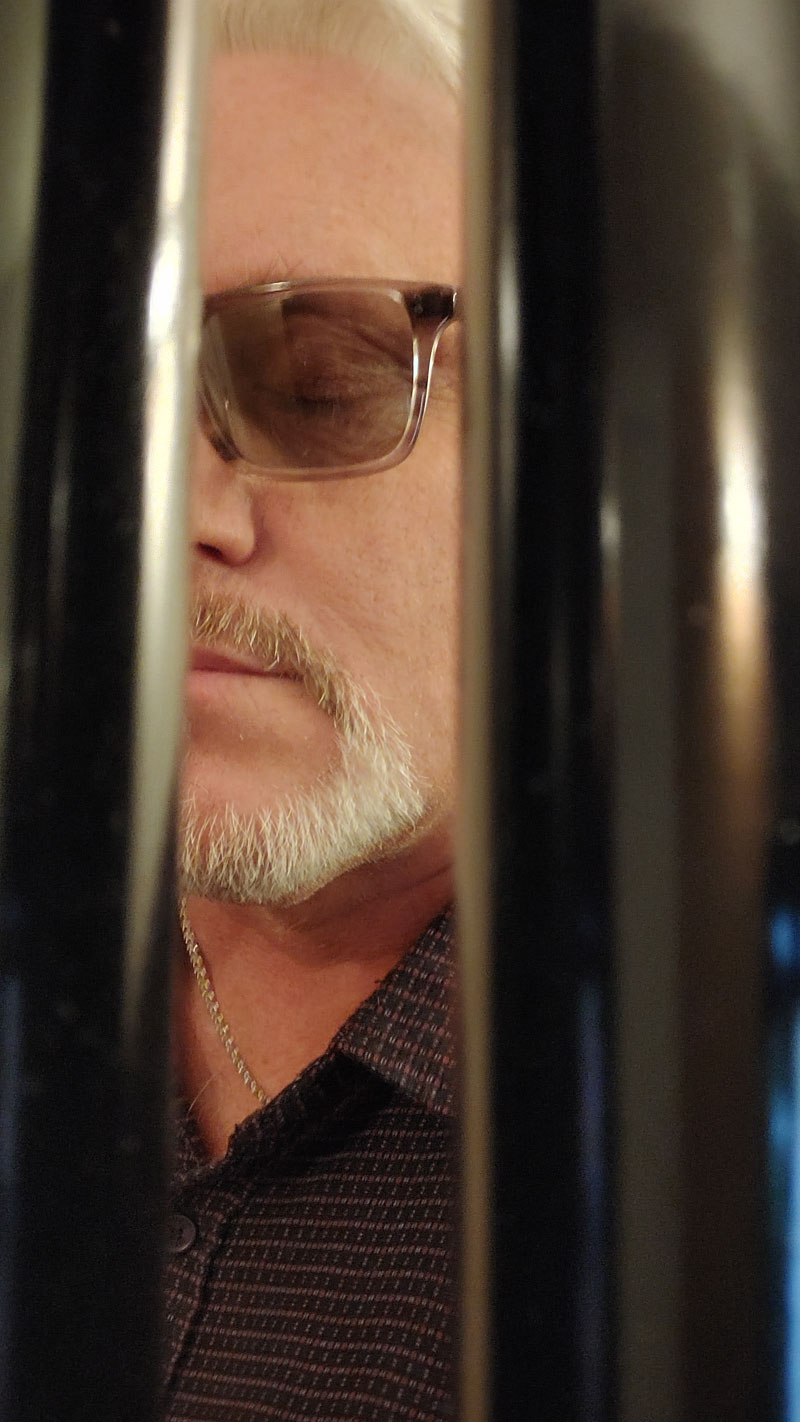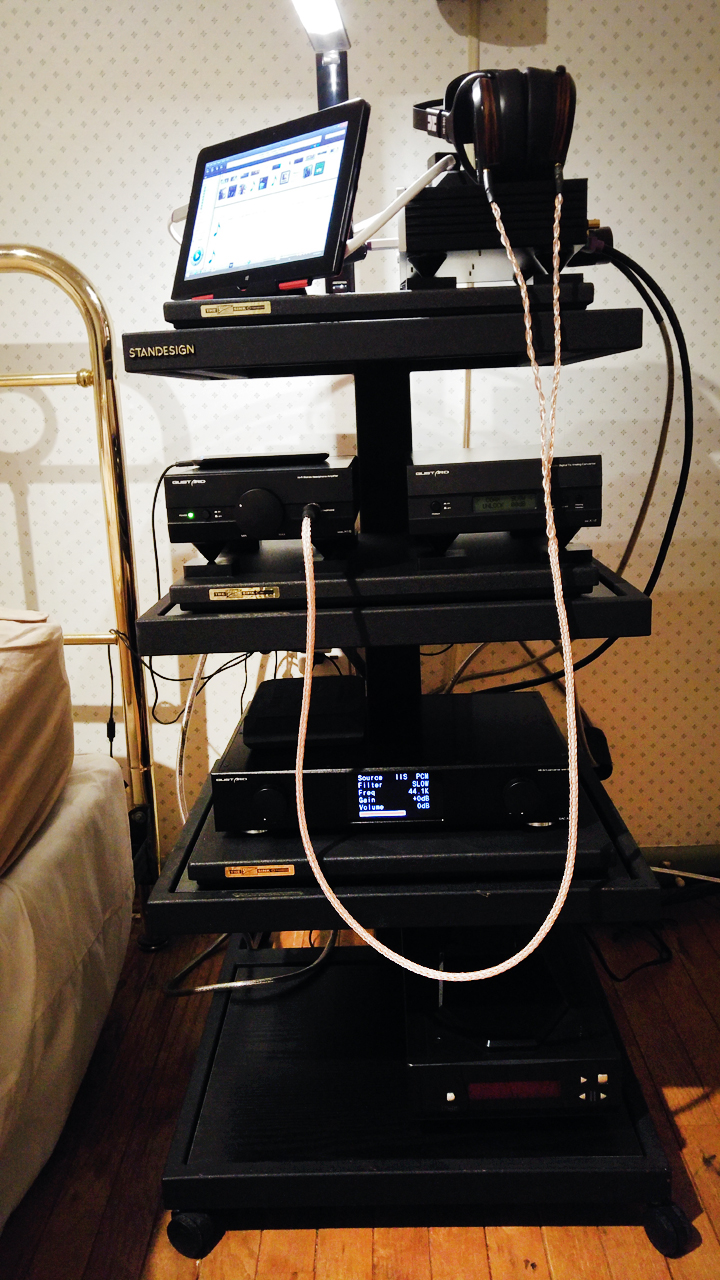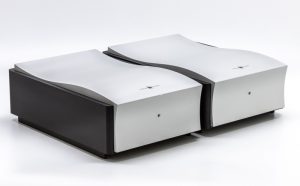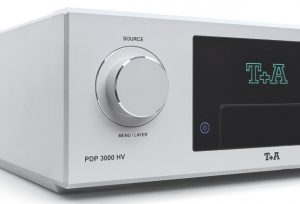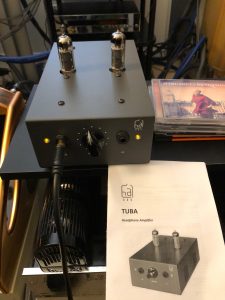I've long been a fan of both Tube amplifiers and Class D amplifiers, and here, finally, I get to check out their love child. Is it an illicit union, a chimera, or something completely new and wondrous to hear?
I think a little history is in order.
I was solidly in the solid-state camp long before I caught the hollow-state bug. I had what I called the "mighty mouse" Meitner MTR-100's, and was happy as a clam until the early 90's hit and I started having dreams of my Dad's Heathkit tube amplifier and the wonderful music it made in his study. I thought of my Dad, hunched over his workbench, soldering together those mysterious bits and the look of pride on his face when he fired it up and those tubes came alive with a comforting glow. It made quite an impression on me, and my memories were still vivid some thirty years later. It was time for me to dive into this vacuum tube obsession.
I'm a bit obsessive-compulsive, so I didn't just dip my toe in the vacuum tube waters; no, I had the diving bell brought in, got fully pressurized, and headed straight for the Marianna Trench. I started a series here at PF I called "Tube-Fest," and in the span of a year, officially 18 (unofficially about 35) tube amps of every imaginable configuration and tube variety came and went from my listening room. It was really an insane thing to do, but the manufacturers seemed to enjoy it, and kept sending more and more amps my way.
Near the end of the Tube-Fest quest, I thought I had discovered my sacred chalice. In an article called TUBE FEST part IV - The Quest for the Holy Grail, I revealed that the Blue Circle BC-2 amplifier had achieved that vaunted status. The BC-2 was a unique design, having a single 6SN7 tube in the front end for voltage gain with two interstage bipolar transistors and ten bipolar transistors for the output. The tubes were run single-ended with zero global or local feedback with five of the bipolars used as current valves, and the other five as current "mirrors," providing a constant current source.
With the discovery of the BC-2, I thought the Tube-Fest quest was over―the sound of chubby Bavarians playing umpa, umpa, um, pa-pa, fading off in the distance. What I didn't expect was an even more glorious Grail appearing out of the shadows. At first blush, the beguiling Bel Canto Evo 200.2s appeared as a Jezebel, a beautiful, yet treacherous heretic. She completely forsook the blessed tubes and replaced them with a Tripath Class "T" module―a digital thorn, by any other name. It took her a while to woo me, but I soon learned that she was not the spawn of the Devil but a truth teller worthy of Grail status.
This was something entirely new to me and it shattered my conceptions of what a "digital" amplifier should sound like. At that point, my only prior experience with Class D was a brief audition of the Spectron amplifier, provided to me by Mike Pappas who had reviewed it quite favorably for PF. The experience wasn't entirely good. I could hear in the Spectron some of the great potential of Class D, but for me, the tonal presentation was exaggerated, almost "technicolor," painting primary colors with hardly any pastels. The soundstage was artificially precise in a cardboard cut-out, 2D sense, lacking roundedness and depth. The Evos, which I ran as differential monoblocks, were nothing of the sort. They presented a natural, three dimensional, and veil free view of the musical performance.
I interviewed Bel Canto's chief engineer, John Stronczer, in September of 2000, and something he told me back then struck a chord with me. When I suggested that audiophiles might pick up one of those Tripath modules and build for themselves "a poor man's Evo," John corrected me by pointing out that the module must be implemented with great care for it to come close to audiophile quality. All the analog aspects―grounding scheme, power supply, short signal paths, and the entire input circuit―must be done right, or you will end up with a very poor sounding, poor man's Evo.
Know Your Nephilim
So if you read my last installment, "PF's Rip Van Winkle Awakens," you know that I had taken an extended hiatus and up until about seven months ago, my listening experience had been an exercise in anachronisms. I was still using the same dusty but trusty gear I had back in 2003, including the beloved Evo. I had no idea what was in store when I started to re-build my review system and began reading about the latest in amplification. Who would have guessed that Class D would become the new rage with new gurus arising from places like Belgium and Denmark? But what about this new hybrid category that merged Class D with a classic vacuum tube input buffer? That's rather old school. Audiophiles have been tuning their systems by combining vacuum tube preamps with solid state amps for years. Heck, I combined a Melos 222B preamp with my Meitner MTR-100s back in 1990 and thought I had the best of both worlds. The question remains however, whether those same vacuum tube virtues will eliminate the new Class D vices. Could the beloved vacuum tube raise the Class D game to a whole new level? It could be the equivalent of the "Sons of God" merging with the "Daughters of Man," and you know what that gets you―Nephilim!
The Basics
The M1200 has an input buffer that features a PS Vane 12AU7/ ECC82 vacuum tube, running class A in a zero feedback circuit, powered by its own analog power supply. The input stage is married to, or "plays" a modified Class D, ICEpower 1200AS1 module. This combination yields arc welder power stats. There's a whopping 600 watts into 8 ohms, 1200 watts into 4, and enough juice to handle musical transients into a 2 ohm load. And if that's not impressive enough for you, we're looking at a bandwidth of 10Hz – 45kHz +/- 3.0dB, with crazy damping factor figures at 50Hz: 8Ω >1100; 4Ω >550.
I'm calling this "Nephilim Class" amplification. The only thing these giants are missing is two rows of teeth and polydactylism.
Let's look at some of the other physical attributes that weigh heavily in the M1200's favor...and pardon the pun.
Size and Weight
The monoblocks certainly look the high-end part with the "Stellar" line's stylish chassis work. As one would expect from PS Audio, the fit and finish is excellent, but what really sets these apart from other Class D amplifiers I've recently examined is their dimensions and weight. They are a compact, but not tiny, 17"W x 3.75"H x 12"D and they weigh a respectable 27 lbs. each. In comparison to the VTV Purifi or the Benchmark AHB2, the M1200 has far more giant-like girth and heft.
It's not difficult to make the argument here that form follows function. When you pop the lid, you will certainly find some open real estate, but the placement of the power supplies, tube buffer, and Ice module, are obviously taking advantage of the benefit that distance provides. Sure, you can throw money at shielding power supplies, but when it comes to radiated fields, a little distance from your sensitive components is far more effective.
The M1200 innards. Photo by Stu
Check out how PS Audio has placed the tube buffer board and its capacitive reservoir as far from the power input and digital module boards as possible.
The thick cabinet walls provide most of the heft, and these too serve the dual function of shielding the M1200 from your other close by components as well as providing some mass loading to minimize vibrations. This superior cabinet shielding will allow you to stack the monoblocks, if you absolutely must, but do yourself a favor and separate them. This amplifier greatly benefits from isolation and vibration damping, and yes, I'll be addressing this point in more detail later.
Power-a-plenty
This is Nephilim power, the kind that can look any speaker load in the eye and laugh. This might not be as significant to folks with reasonably sized rooms, with reasonably efficient speakers presenting reasonable loads, but it's a godsend for us reviewers who are often faced with not-so-reasonable combinations. This amplifier makes those funky speaker / amp interactions a thing of the past.
But what about the average audiophile? Should you be concerned that this giant of an amp will be too coarse and brutish for your needs? No worries. This giant walks quite softly for one carrying such a big stick. Psst....I hear he was in glee club and majored in women's studies. I know something of the delicacy and pastel shades painted by great tube amps, SETs in particular, and I can report that the M1200 handles these gentle, nuanced passages as well as any of them. You don't need to turn up the volume to hear the fine textures. It's all gloriously there at very modest listening levels.
Cool running
No, not the Jamaican bobsled team. If you've ever had to sit in your listening room with just your underwear on and the window open in the dead of winter, you will understand why I think massive power with cool running Class D is such a wonderful thing. One can only imagine how hot things would get if you were running a Class A amplifier with similar power capabilities.
Bi-wiring done right
Each channel has two complete sets of custom machined binding posts. This setup simplifies using two sets of speaker cables instead of a "shotgun" configuration. This makes it easy to mix and match cables to your heart's content as well as maximizing the total contact area for your connectors. I started off with Morrow Audio's SP-7s on the bottom and their SP-4s on the top, then mixed them with both the Audio Sensibility Signature and Statement cables. I finally settled on a pair of Statements on the tweeters and a pair of Signatures on the woofers. The M1200's posts will take either beefy spades or banana plugs, and with two complete sets per channel, it doesn't matter if all your cables have only one style of connector. There is no nasty doubling up of spades on each post or having to use banana to spade adaptors.
In my case, it's even more significant to have double binding posts. I'm running stereo subwoofers that are also connected to the amp's binding posts. I use banana plugs on the subwoofer cables and put them on the same binding posts as the spaded speaker cables that feed the tweeters on the Usher Dancer Mini-X loudspeakers. These two way speakers feature completely separate crossover boards for the tweeters and woofers located on opposite walls inside the cabinet. With the woofer covering such a large swath of the music, it makes sense to me to keep it as free from interactions as possible. If there is any emf, current eddies, or foobie dust being back-fed from the subwoofers' power supplies, I don't want it messing with my pristine midrange. It seems intrinsically right to have the tweeter and woofer drivers completely separated, mechanically and electrically, from their crossover boards all the way back to the amplifier terminals.
Thank you PS Audio for doing this right.
It's All About the Input Stage
As I move to the more subjective aspects of this amplifier, I have a bit of a confession to make. I tend to develop friendships quickly and easily with like minded people. These friendships normally don't interfere with the review process, but I'd be lying if I told you they didn't have any influence. It was for this reason (concern about influence), that I decided NOT to do a pre-publication interview with Darren Myers, the principal designer of the M1200's.
I mean c'mon, what's not to like about this guy!? He's one of us. He's a bona fide audionut, who from a young age, obsessed over his system and the fidelity of his music. Then, he takes his audio passion to school, gets the engineering skills he needs, and makes that passion his day job. Show of hands. How many of us old timers wish we could go back and do it like this? Now here's the real kicker: Rather than becoming one of those white coat, stuffed shirt, measurement wonks, this Darren guy had the very good sense (and cojones) to let his ears be the final arbiter of what sounds best.
Darren Myers understands, as John Stronczer did, so many years back, that the attention paid to the more conventional, analog circuitry, can make or break the sound of a so-called "digital" amplifier. Rather than using the now ubiquitous switching mode power supplies and off the shelf input buffers provided by the likes of Hypex, ICEpower and Purifi, Darren went old school with a zero feedback, vacuum tube input buffer powered by its own analog power supply. He said this buffer "plays" the ICEpower module and not the other way around. My own listening experience tells me he's dead right. Whenever I made a change to the input section of these hybrid amplifiers, be it the vacuum tube, damping, or in the case of the VTV amplifier, changing opamps, the differences were profound and clearly audible. It stands to reason then, that most, if not all, of the sound characteristics associated with the M1200 come from the analog input stage and not from the digital module.
So let's take a deeper look at what makes the M1200's input module sound so uncommonly good. If the input buffer is the concertmaster that plays this Class D violin, we need to examine the three elements that give it this virtuoso skill.
Power Supply
My experience with power supplies tells me that they may be the single most important element for realistic soundstage presentation. A power supply upgrade will almost invariably improve every aspect of soundstaging: depth, width, height and 3D imaging. You will likely also get more midrange body and deeper, tighter bass. This is precisely what I hear with the M1200 with the sensitive tube buffer powered by its own analog power supply and a separate, very robust bank of capacitors.
I think we have to acknowledge that all power supply designs are not created equal. The measurement guys will tell us a switching mode power supply, with plenty of filtering, can provide the same clean power as a linear supply and do so more efficiently. They would go so far as to say that you can hear absolutely no differences between competent power supply designs. That may sound good on paper, but in my recent experience, it's not always the case. Take the case of the VTV Purifi mono blocks that received my writer's choice award. Its topology is very similar to the M1200, having a tube based input board designed by Andrew Sparks of Sparcos Labs, and a Purifi digital output module. Andrew chose to power his buffer with the same Hypex SMPS that powers the Purifi module, and though a clever design that sounds quite good with his onboard discrete opamps, it just can't match the size and depth of the M1200's soundstage, nor float images quite as realistically. Same too with the venerable Benchmark AHB2, which also uses a switching mode power supply. The Benchmark has many virtues, such as excellent dynamics and tonal balance, but it also comes up short in "you are there" soundstaging. Its left to right positioning is very precise, but the front to back positioning seems foreshortened. This leads to what I call the "cardboard cutout effect," where the imaging is hyper-2D but lacks the rounded floating cylinders I associate with live performances.
Inside the VTV Purifi - for comparison.
Zero Feedback
Ahh feedback, the boon and the bane of the audio engineer. Now, I'm no engineer, and I don't even play one on TV, but I've been told this simple truth by some of the best engineers I know: The easiest way to make your amplifier measure great is to use an abundance of local and/or global feedback in your circuit. There are a number of these actual, or would be, engineers, who firmly believe that if it measures better, it is better, regardless of our "delusional" audiophile perceptions.
For me, the error in this proposition is the fact that we are currently unable to measure and correlate everything we perceive. What measurements will tell me that the M1200 does imaging, and particularly soundstage depth, better than the AHB2? How does one measure the float and cylindrical qualities of sonic images? There might be a large group, or family of measurements, that could give us this answer, but so far the lab coat boys haven't revealed them or showed us how they correlate.
I might not know how to measure it, but I can clearly hear how even modest amounts of feedback can effectively cripple the soundstage performance of an amplifier. This conclusion may not have come from a rigorous, double-blind, level-matched testing environment, but I think it came from the next best thing. During my Tube-Fest days I was introduced to the Manley Audio SE/PP 300Bs, an amplifier so unusual, and so offensive to purists, that my one time critic / foil, Herb Reichert, disparagingly referred to it as the "two-headed baby." I wrote all about it in my review titled, Beneath the Planet of the Son of Tube Fest -or- Manley Makes Me Mental with the SE/PP 300B. This appeared in the print issue, Volume 6, No. 2 (HERE).
The Original Manley SE/PP 300B, or Two-headed Baby - picture by Manley Audio
The SE/PP 300B was David Manley's answer to the Single Ended tube craze with a major, mad scientist twist. It was a monoblock design with input stages utilizing a 12AT7 tube and a unique mil. spec. GE 7044 twin triode, driving a glorious pair of blue glowing, 300B tubes (hence Herb's "two-headed" baby reference). The twist came from having two prominent switches on the top, one a toggle, which enabled you to switch, on the fly, from Single ended to Push-pull operation, and the other, a dial, which allowed you to set negative feedback in 1db increments from 0 to 10. Think of the implications of this? Manley had eliminated nearly all the variables that could get in the way of listening directly to the effects of feedback―same tubes, same circuits, even the same transformer.
After completing my single-ended versus push-pull analysis, I had this to say about feedback:
"So what about feedback? Well, take what I have described as the drawbacks to the push-pull sound and multiply by a factor of two. There is no question in my mind that the effects of feedback are far more deleterious and that even in systems with mediocre resolution, the effects of feedback can be heard. As you dial in more feedback, the soundstage depth decreases, like the doors closing on Mystery Science Theater 2000, the micro-dynamics are progressively sucked dry and your midrange bloom becomes a blip. Feedback is an equal opportunity spoiler—the effect is more dramatic when operating in SE, but it will still ruin your day if you're in PP."
My younger self could just as well have been describing what I heard when comparing the M1200 to the VTV Purifi and Benchmark AHB2. On the Mad-Scientist-dial-in-the-feedback scale, I would put the VTV Purifi's at a 4, the Benchmark AHB2 at 5, and the M1200's at the dead zero that PS Audio claims.
There's a technique, or skill, involved with hearing depth of field, and I have learned that audiophiles possess it to varying degrees. Fortunately, this is one of those cases where you don't have to be an expert to hear the differences. If you play the M1200 in a reasonably high resolution system, I'm confident that you will conclude, as I have, that it's a soundstage / imaging giant, regardless of price.
Valvular Verity
The M1200 is exceptionally neutral over a very wide bandwidth, and that's no small feat for a hybrid vacuum tube amplifier. This isn't my father's Heathkit (or Oldsmobile). There is none of that classic tube coloration―that often overripe caramel coloration that was the product of a prominent lower midrange coupled with a rolled off top end. The M1200 does, however, preserve a very large measure of the good stuff―the tube "magic" that hollow-staters know so well. You can hear that characteristic flesh on the singer's bones, and that lush wood resonance in the sound of the strings. You can hear more of those subtle harmonics and textures that make a violin sound different from a viola, and a Bosendorfer from a Steinway. You get that uber-believable soundstage, large and enveloping, that gives you such a heightened sense of the size, space and atmosphere of the recording venue. You get that tube-like holographic imaging that delivers so much of the "you are there" experience.
These three elements―a separate analog power supply, a zero feedback circuit, and the magical vacuum tube―have come together to "play" the ICEpower module to near musical perfection. If it's not measurement perfection, I don't really care. It is insignificant to me that a zero feedback, vacuum tube circuit may not fair as well on the test bench. If something reveals to me more of the harmonic textures and gives me a more realistic 3D soundstage, you can call it distortion, voodoo, or Nephilim dust, and it will still be a rose to me. I'm just glad that Darren Myers focused on sound quality, rather than test bench numbers.
Even Baby Giants Having Teething Pains
It stands to reason that baby Nephilim with or without two rows of teeth, are going to have twice the teething pains of ordinary kids. True to form, I had my share of late night teething issues with the M1200.
My initial impressions of this amplifier were extremely good, and I reported on it in PS Audio's online forums. I had listened through the burn-in period enough times to know that an amplifier that sounded this good straight out of the box, would surely be a winner. But in this case, after close to 75 hours, the amps just didn't seem to open up the way I expected. So I got serious about the burn-in, hammering them with my Purist Audio disc for an additional four days. Half that time I had my speakers disconnected and the preamp sending a maximum signal to the M1200's. The other half, I cranked the volume to a very high level with my speakers wired out of phase and placed face to face. This seemed to bring out the upper bass and lower mids quite nicely, filling in what I had initially perceived as a hole (or maybe a divot), in that frequency, but I was still lacking the three dimensional imaging that I was consistently hearing from the VTV amplifier. I also noticed a problem with the soundstage. It wasn't just big; it was unrealistically huge and the ambient hall sounds were so prominent, that they seemed out of place, or at least, out of balance, with the sound of the musicians and vocalists. These sound anomalies made me recall one instance where a particularly well regarded amp had come in for review and ended up having very similar sound issues. I had seriously questioned my ears and was quite concerned that I might have a defective unit, or be the only reviewer on the planet that didn't like this amp. So, I called the manufacturer and asked him what the problem could be. His answer was immediate and concise: "Ah, easy fix Stu. One of the input tubes must have gone microphonic."
Hmmm…could this be the issue with the M1200s? I just happened to have a pair of Herbie's Ultrasonic tube dampers on hand, so I cracked open the cases to give them a try. While inside, I noticed that one of the tubes was not fully seated in its horizontal socket. It stands to reason, to me at least, that the horizontal mounting of a tube may magnify any vibration problems―think lever and fulcrum, angle of momentum, you know, science! So I applied the dampers, buttoned them up and had another listening session and low and behold... the soundstage was transformed!
The anomalies I had identified before were gone. The soundstage was still larger than the VTV or Benchmark, but now, it was realistic, rather than ridiculous. Imaging within the stage was more focused, and three dimensional, approaching the best I have ever heard. The presentation of hall sounds - reverberation, decay, and low frequency atmospherics, were now naturally proportioned with the sound coming from center stage performers and the vocalists seemed to gain a half octave of chest register. All this from reseating a tube and applying a good tube damper!? Astounding.
So now I'm thinking if a little tube / vibration work yielded this kind of return, how about a whole lot more? I went to my attic of audio anachronisms and brought down the Townsend Seismic Sinks and the Black Diamond Racing cones and added them to the mix. And yes, once again, I heard small improvements in focus, detail, and depth delineation. I seemed to have hit on just the right amount of tube and chassis damping, because the M1200s excellent tonal balance and dynamics were unaffected. I know from past experience that you can really muck things up if you go too far.
I finished my experiments by ordering up a matched pair of the Genelex Golden Lion AU7s. These are one of my favorite affordable AU7 tubes and in nearly every application I've tried, they have improved the bass, fleshed out the midrange, and enhanced the soundstage. The Genelex AU7s build happens to be shorter and squatter than the stock PSVanes. It may be a stretch to say that their build mitigates the horizontal vibration issues, and perhaps I should have tried out a new pair of the PSVanes for comparison, but holy smokes, the Genelex tubes sounded so right that I didn't want to mess with perfection. They did their usual trick, giving me more midrange bloom, a touch more grunt way down low, and an even more inviting soundstage pool to swim in.
If anyone might conclude from this that there is an inherent weakness with the PSVane AU7, let me assure you that there is not. Tube rolling is a way of life for me, and my particular flavor may not be yours. I believe that my experience was the odd bounce and there is little likelihood of others having a microphonic tube right out of the box. Nevertheless, I would recommend checking the tube seating when your amps first arrive. PS Audio has made it a five minute task by providing an easy access tube panel on the back. You don't have to take the top half off unless you find the back hatch too small for your hands, or you just want to admire the insides. I found it easier to seat new tubes and install tube dampers with the top lid off.
Expounding on the Unexpoundable
I'm not going to walk you through song after song on my play list, impressing you with my eclectic tastes, and revealing with an elevated patois how the M1200 transformed formerly plebian passages into exalted angelic stanzas. It did actually, but that style is better suited to the audio shamans than it is to a raconteur like me.
I've been critically listening to these amps for over four months now and doing a lot of comparisons. I didn't intend to have the last word with my review of them, but others have beaten me to the punch and have done a fine job of descriptive amplifier vivisection. Normally, I wouldn't read anyone else's review until my own was finished, but this time my curiosity got the better of me. These other writers, and you probably read their work and know who they are, did an excellent job of revealing what they perceived as the strengths and minor weaknesses of the amplifier. The most prominent strength noted was, of course, the M1200s incredible deep, controlled bass, and its lightning quick agility―the ability to start and stop on a dime. This agility may be a two edged sword for the M1200. The strength is obvious, but on the other side of the sword lurks a more subtle weakness. Apparently, when an amplifier can get on and off a note so quickly, the unintended consequence may be a tendency to truncate a note's natural decay. Lastly, we're told that the M1200 may be slightly thin and bright on the top end as compared to more costly Class A/B amplifiers, and may have a ringing or glare as you move up the musical scale.
I could hear some of these things, especially the strengths, but honestly, with the few changes I made, I could no longer detect any of these identified weaknesses. Even before my tube swapping, damping, and vibration efforts, finding these flaws was the equivalent of straining out a gnat. I understand that most writers are constrained by the "rules" that say, "thou shalt not modify the review sample." Yes, there are good reasons for the rule, but in this case, it would be a far greater crime if I didn't tell you how ridiculously easy it was to fix the weaknesses. So, if you are concerned about world class decay, imaging, and a lush, glare-free top end (and who wouldn't be), I suggest you buy a set of Herbies Ultra tube dampers, use isolation feet or platforms, install a set of Genelex Gold Lion tubes (or your equivalent), and keep a cool 163K in your pocket.
I'm comparing the M1200 to a few current peers, and my sonic memory of a whole lot of amplifiers that have passed through my doors in the past 30 years. With that very personal context, I can say that the M1200 is the most weakness-free, non-amplifier sounding amplifier I have ever heard. It's one of those rare times when I can say that an amplifier sounds like "nothing at all." Really. The M1200 just doesn't have a telltale sonic signature. I can't say this is a bass-head's amp, a dynamics amp, a neutral tonality amp, a revealing, high-resolution amp, or a 3D soundstage amp because it's all of those things and more. The whole of the M1200 is truly greater than the sum of its parts and I'd be foolish to dissect its attributes and try to place them in some form of hierarchy.
So, can I just call this amplifier an ultra wide band, dynamic, linear, uncolored, three dimensional epiphany machine, and be done with it? I probably should, but sadly for you, that's not what they're paying me the big bucks for.
Words like "transparency" and expressions like, "a clean window," "veils lifted," and "spooky real" just won't cut it for this one. So as I struggle to expound upon the un-expoundable, I'm just going to use a word that is simple and commonplace to describe the performance of this very uncommon amplifier: realism. I'm in pursuit of realism in my listening room. I won't be satisfied until my sessions are like stepping into a Holodeck of the Star Trek variety. I want to be "there" for the performance and forget all about my room and the gear. This is exactly what this stellar amplifier does for me. It effortlessly transports me to the venue with its wide band, dynamic, linear, uncolored, three dimensional realism.
Realism is when your amplifier acts like a microscope revealing every tweak and equipment change without ever being hyper-detailed, overbearing or overwhelming. You simply hear the differences when you decide to listen for them. The M1200s have outstanding resolution that greatly aids my ability to hear differences repeatedly under varying conditions. There have been many changes in the past four months, including loudspeakers and cables, DACs, streaming devices, and power supplies, and the M1200s have faithfully revealed the sonic effects of each one. I could even detect the very subtle sound differences between ethernet cables and isolation devices. Talk about scalable! I'm confident that I can make system improvements long into the future, and I will never be concerned that the M1200s are holding me back.
Realism is when you can't help noticing the change in acoustic environments on many of your favorite recordings. When I listened to Melody Gardot, Live in Europe, I could plainly hear each time the venue for a song changed, and that was well before the lyrics or the liner notes had given me a clue. There are 17 tracks on this gem, culled from concerts in Barcelona, Lisbon, Paris, Utrecht, Amsterdam, and London and the M1200s make it all too easy to hear the hall atmosphere changes. The same thing occurs even with studio recordings. These recording affectations have become so obvious (and annoying) that I have, on several occasions, yelled at the imaginary producer in the room for screwing up an otherwise great song. Such was the case with Eva Cassidy's "I know You By Heart" on her album, Songbird. Eva's vocal is centered in what sounds like a massive echo chamber, while the accompanying instrumentalists and chorus singers are not. Seriously, I want to throat-punch the guy.
The same thing occurs with about 75% of the studio creations I listen to, and it doesn't seem as though I will acclimate with time. I adore Leonard Cohen's last three albums Old Ideas, Popular Problems, and You Want it Darker, but I have to say that the "Leonard-close-mic'd-alone-in-the-booth-and-then-everyone-else" sound, has not worn well with me. This "Leonard" recording style has fortunately become a little less prominent with each succeeding album. The best mix of the three is heard on You Want it Darker, where Leonard's son, Adam Cohen, took over the producing reins from long time collaborator, Patrick Leonard, but the full production transformation is left for Thanks for the Dance, where, with his father's passing, Adam has exclusive control and creates the best artificial soundstage of the bunch. This progression wouldn't have occurred to me, I and certainly wouldn't have been so attuned to the production faux pas, had the M1200s not made them so nakedly obvious.
Realism is what allows me to play Qobuz resolution roulette and choose correctly, without looking, whenever a 96 or 192khz song is playing, and it's the same realism that makes me hear the subtle differences between playing songs on AURALiC's Lightning software, Sim Audio's Moon Mind Control, or with Roon.
Lastly, and most importantly for me, realism is when my emotional connection to the music is so intense, that I'm either in a jaw dropped state of awe or a snotty mess with tears flowing. I'll give you a few examples. Listen to Andreas Vollenweider's Quiet Places, released this past October, and see if the interplay of harp, cello and drums, with their diverse textures, harmonics, and rich sonority, don't take your breath away. It doesn't even matter that the soundstage is a weird studio creation where Andreas' harp sounds forty feet wide , and Isabel Gehweiler's cello sounds like twenty. The musical message given in the height of the pandemic is one of joyous repose.
Then there is Leonard Cohen's Thanks for the Dance. This is masterful, deeply personal poetry with its message made even more powerful by a hauntingly sparse, yet beautiful accompaniment. My hat is off to you, Adam Cohen, for capturing, so perfectly, the mood and emotion of your Dad's final words. I played this album for Noelle, my significant other, who is an accomplished writer, and also happens to have better ears than me, and we both sat completely still and quiet until the final piano chord of "Listen to the Hummingbird" drifted away in the room. It was like the gentle passing of Leonard's soul. She turned to me and said, "wow, that gave me chills...poetry set to music." I quietly stuttered my agreement, which probably seemed less significant to her than it was for me, because Noelle, being blind, could not see the tears running down my cheeks.
Leonard Says It's a Wrap
This amplifier is not a giant killer. It is the giant―an ultra wide band, dynamic, linear, uncolored, three dimensional giant. Like the biblical Nephilim, we have taken something of the sons of God—an exquisite zero feedback analog tube circuit, and mixed its DNA with something of the daughters of man—a powerful Class D output module, and have birthed something that is greater than, and altogether different from, the sum of its parts. It's a new race, a new breed of amplifier that laughs at speaker loads while delivering near perfection in every performance parameter.
PS Audio is selling giants, and at $6000 a pair, most of us can actually afford one. That's a rather uncommon gift bestowed upon us less pecunious 'philes, and one which I just couldn't pass up. I'm buying my review pair and will thoroughly enjoy taunting all the other higher-priced amplifier grasshoppers.
In memory of my favorite poet-lyricist, Leonard Cohen, I'll close out this installment of Stu's Space with a poem about the Stellar M1200 I call, Better Than.
Better than the Blue Circle BC2 monoblocks,
that I once called my "Holy Grail."
Better than the Bel Canto Evo's that topped it,
when I thought they couldn't fail.
Better than all those amps,
during my Tube Fest phase,
drove me nearly crazy,
in those old school glory days.
Better than the VTV Purifi, or the Benchmark AHB2,
that put up quite a fight,
but couldn't follow through.
Better than I thought possible,
from a tube and Class D amalgamation.
Better sign off now
because...
It's just too much bloviation.
Stellar M1200 Power Amplifier
Retail: $5998
PS Audio
4865 Sterling Drive
Boulder, Colorado 80301
720.406.8946




